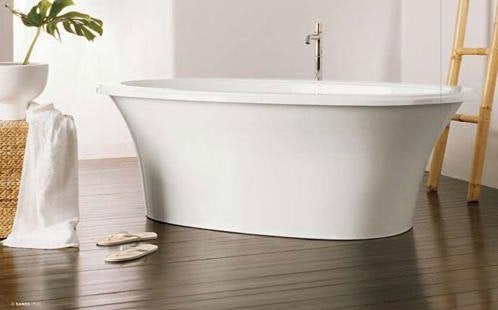They are making several good pointers on Installing A Bathtub in general in this article beneath.

Mounting a bathtub isn't exactly rocket science, however it does need solid plumbing, carpentry, as well as occasionally, tiling abilities. Replacing an old bathtub with a new one is likewise a moderately difficult job. If the old bathtub is easily available, the project can move quickly; if you have to open a wall to get rid of the old bathtub and also place the brand-new bath tub, the job is a lot harder. In either instance, the task is within a residence handyman's abilities, although you will certainly require an assistant to leave the old tub as well as set in the new one. Make sure you have qualified on your own for the work and also fit trying it. Instead of hiring a contractor to take control of a halfway-completed task, it is better to consider using one prior to you begin. Possibilities are you may need an expert plumber to make tube links.
This short article will help you mount a brand-new tub in your shower room if you have currently purchased a new tub and don't require to alter the plan of your previous water supply pipelines.
Your devices as well as material list must consist of the following:
Planning for the Installment
Firstly, the supporting structure supplied with the bath needs to be fitted (if called for) according to the maker's directions. Next, fit the faucets or mixer to the tub. When fitting the faucet block, it is necessary to ensure that if the tap features a plastic washing machine, it is fitted between the bathroom as well as the taps. On a plastic bath, it is additionally practical to fit a supporting plate under the taps device to avoid strain on the bath tub.
Fit the adaptable tap adapters to the bottom of both taps making use of 2 nuts and olives (occasionally supplied with the bathtub). Fit the plug-hole outlet by smearing mastic filler round the sink electrical outlet hole, and then pass the electrical outlet through the hole in the bath. Make use of the nut supplied by the supplier to fit the plug-hole. Analyze the plug-hole electrical outlet for an inlet on the side for the overflow pipe.
Next off, fit the end of the adaptable overflow pipe to the overflow electrical outlet. After that, screw the pipe to the overflow face which ought to be fitted inside the bathroom. Ensure you make use of all of the provided washers.
Link the catch to the bottom of the waste outlet on the bath tub by winding the thread of the waste electrical outlet with silicone mastic or PTFE tape, and screw on the trap to the electrical outlet. Connect the bottom of the overflow tube in a similar manner.The bathroom should currently prepare to be fitted in its final setting.
Removing Old Touches
If you need to replace old faucets with new ones as a part of your installment, after that the first thing you should do is detach the water system. After doing so, activate the taps to drain any water remaining in the system. The procedure of removing the existing taps can be quite problematic due to the restricted accessibility that is frequently the case.
Use a basin wrench (crowsfoot spanner) or a tap tool to undo the nut that connects the supply pipelines to the faucets. Have a cloth prepared for the continuing to be water that will come from the pipelines. Once the supply pipes have actually been eliminated, make use of the same tool to loosen the nut that holds the faucets onto the bath/basin. You will certainly require to stop the single taps from transforming throughout this procedure. Once the taps have been eliminated, the holes in the bath/basin will certainly need to be cleansed of any old sealing compound.
Prior to going on to fit the new faucets, contrast the pipe connections on the old taps to the new taps. If the old taps are longer than the brand-new faucets, then a shank adapter is required for the new taps to fit.
Setting up the Bath tub
Making use of both wood boards under its feet, put the tub in the called for placement. The wooden boards are valuable in uniformly spreading the weight of the bathtub over the area of the boards instead of focusing all the weight onto four little factors.
The following objective is to ensure that the bathtub is leveled all round. This can be accomplished by inspecting the spirit level as well as readjusting the feet on the bath tub till the level reviews degree.
To install taps, fit the bottom of the furthest adaptable faucet adapter to the ideal supply pipeline by making a compression sign up with; after that do the very same for the various other faucet.
Activate the water supply and check all joints and new pipework for leaks and tighten them if necessary. Fill the bathtub and also check the overflow outlet and the typical outlet for leakages.
Lastly, take care of the bath paneling as described in the maker's user's manual. Tiling as well as sealing around the tub ought to wait until the bathtub has been made use of at the very least when as this will certainly settle it into its final placement.
Suitable New Touches
If the tails of the brand-new taps are plastic, then you will need a plastic port to prevent damages to the string. One end of the port fits on the plastic tail of the tap and the various other end supplies a link to the existing supply pipes.
If you require to fit a monobloc, after that you will certainly need reducing couplers, which attaches the 10mm pipeline of the monobloc to the conventional 15mm supply pipe.
Next, place the faucet in the mounting opening in the bath/basin making sure that the washers are in location between the faucet and the sink. Safeguard the faucet in place with the manufacturer given backnut. When the tap is firmly in place, the supply pipelines can be linked to the tails of the taps. The faucets can either be linked by using corrugated copper piping or with regular faucet connectors. The previous kind ought to be connected to the faucet finishes first, tightening only by hand. The supply pipes can later be attached to the various other end. Tighten up both ends with a spanner after both ends have been attached.
Tiling Around the Tub
In the area where the bathroom satisfies the floor tile, it is required to secure the joins with a silicone rubber caulking. This is important as the installation can move sufficient to split an inflexible seal, causing the water to pass through the wall in between the bath and also the tiling, bring about complications with wetness and feasible leaks to the ceiling listed below.
You can choose from a selection of coloured sealants to assimilate your fixtures and also fittings. They are marketed in tubes and cartridges, and also are capable of securing gaps as much as a size of 3mm (1/8 inch). If you have a larger void to fill, you can load it with spins of soaked paper or soft rope. Remember to constantly fill up the tub with water prior to securing, to enable the activity experienced when the tub remains in usage. The sealant can split fairly early if you do not take into account this motion prior to sealing.
Conversely, ceramic coving or quadrant tiles can be used to border the bathroom or shower tray. Plastic strips of coving, which are easy to use and reduce to dimension, are also quickly readily available on the market. It is recommended to fit the ceramic tiles utilizing water-resistant or water-proof glue and cement.
How to Install or Replace a Bathtub
Find Your Dimensions
The first step in any bathtub installation or replacement is to select the right size tub for your bathroom. Start by measuring your existing bathtub’s alcove from wall to wall. The standard size for bathtubs is around 5 feet long and 30 or 32 inches wide. Purchase the size that’s closest to your previous tub.
After you’ve measured, you’ll need to figure out what type of tub you need. Face the alcove. If the drain is on the right-hand side, you’ll need a right drain tub. If it’s on the left, get a left drain tub. Easy enough, right?
Disconnect the Water Supply and Drain Assembly
Before you can start on your removal, make sure that you turn off the tub’s water supply. Some bathrooms have a shutoff valve, but if you don’t see one, you’ll need to turn off the supply at your house’s water main. Once the water’s off, open the valves to release any remaining air in the supply lines.
Then, disconnect the tub drain flange. This process varies based on the type of drain you have, but in most cases, you’ll need a drain flange removal tool to perform this task. If you’re feeling handy, you might be able to use a pair of needle-nose pliers to twist and pull the flange.
Now comes the fun part. In order to disconnect the drain assembly, you’ll need to be able to get to the space underneath the tub. You might need to access the tub drain from a crawlspace or a basement. Don’t forget to take a pipe wrench with you, as you’ll need it to loosen the pipe at the connection.
Cut Out the Old Tub
After removing the drainpipe assembly, you can take out the old bathtub. Cut a strip above the tub edge in the wall surrounding the bathtub that's about 6 inches in height. The tools you need here may vary depending on the type of wall surround you have in the alcove. If you’re cutting drywall, use a drywall saw and remove the section of the wall all the way down to the studs. If you have tile, you’ll need to use a grinder with a diamond blade to cut through the grout line. Then, use a chisel to remove the individual tiles. Take care here not to cut through any studs.
Find the tub flange. Remove the screws that attach the flange to the studs in the wall. At this point, the tub should be freed from the wall.
Once you’ve removed the flange, use a utility knife to cut away the caulk between the tub and the floor. When this is done, you should be able to lift the tub up and out of the alcove. Keep in mind that, depending on what it’s made of, the old tub could be tremendously heavy. You should plan to have a friend help you move it just in case.
Install the New Tub
Before you make any adjustments to the area, place the new tub in the alcove to make sure it fits properly and that the tub drain lines up with the P-trap underneath the floor.
Remove it and install a 2 x 4 ledger board. Measure the tub’s flange, then mark that height on the wall. Screw the ledger board to studs in the wall. This will help to support the weight of the tub.
Once the ledger board has been installed, go ahead and secure the drain to the tub. For this step, you’ll need some plumber’s putty. Roll a small amount of putty in your hands and wrap it around the underside of the drain flange. Push the drain into the tub from underneath the tub.
When the drain has been attached, connect the overflow drain. To do this, you’ll place the gasket on the overflow elbow and move it behind the tub. Once that’s on, connect the overflow pipe and the drainpipe, but take care not to overtighten.
Secure the Tub
After the connections are in, it’s time to set the tub in place. Before you start, make sure the flange lines up with the markings you made in Step 4. Because the ledger board holds the tub in place, it’s important that it matches up. If not, you’ll need to remove it and readjust.
Once your measurements line up, attach the flange to the studs on all three sides of the wall. Please note that you should not screw the flange to the wall. Instead, you should use roofing nails because they won’t rust over time. When the tub is in place, install the baseboard and the molding in front of and around the tub.
Repair and finish off the drywall or tile that you cut in Step 3. If you’re installing a fiberglass bath surround, now’s the time to adhere it to the alcove.
Then, enjoy your tub! While all these steps might seem intimidating, removing and installing a new bathtub is a relatively easy DIY project that can be completed in a single day. And now, when you settle in for your next bubbly soak, you can enjoy your bath without the distraction of a tub in disrepair.
https://www.homeserve.com/en-us/blog/how-to/bathtub-replacement/

I am just very inquisitive about A Step-by-Step Guide to Installing a Bathtub and I hope you appreciated our article. Those who enjoyed our blog posting plz remember to share it. Thank you so much for going through it.
About This
 Luke Perry Then & Now!
Luke Perry Then & Now! Alfonso Ribeiro Then & Now!
Alfonso Ribeiro Then & Now! Joseph Mazzello Then & Now!
Joseph Mazzello Then & Now! Catherine Bach Then & Now!
Catherine Bach Then & Now! Stephen Hawking Then & Now!
Stephen Hawking Then & Now!